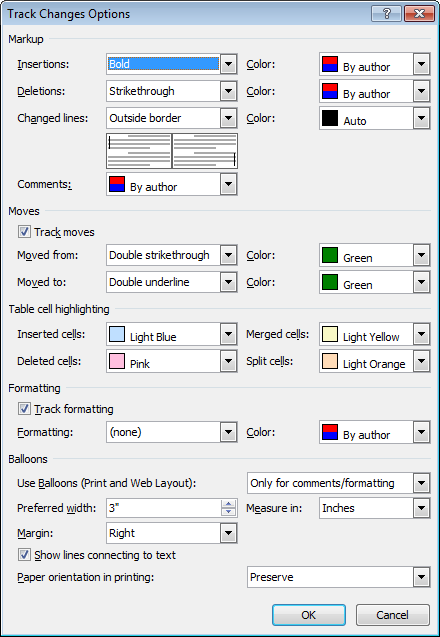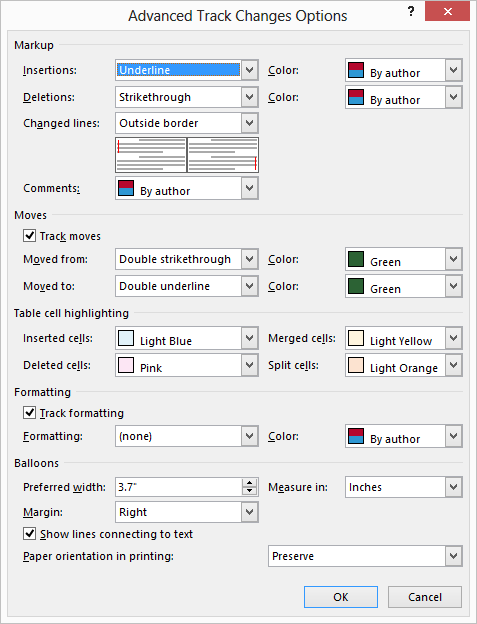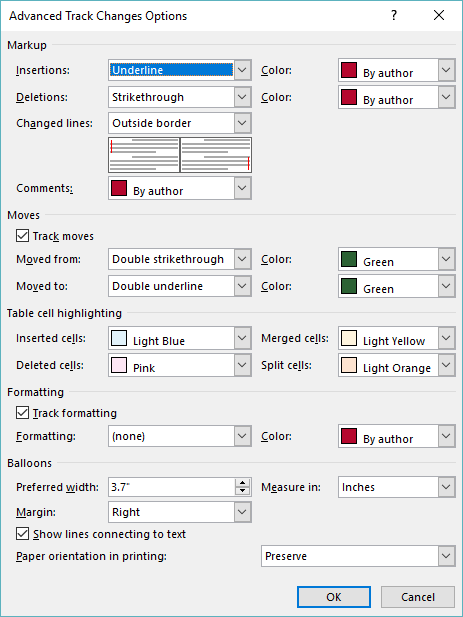How To Get Rid Of Track Changes In Word
Permanently Turning Off the Tracking of Formatting Changes
![]()
Martha works for an attorney who uses Track Changes a lot when working with clients. He is annoyed by having to turn track formatting off all the time. (He doesn't want simple formatting changes to be tracked.) Plus, when he passes the document to a client (via email), if they don't know how to turn off the tracking of formatting changes, the returned document is always full of tracked formatting changes. Martha wonders if there is a way she can turn off the tracking of formatting changes forever.
When you turn on Track Changes in Word, the program tracks lots of changes you make. One category of changes it can track are changes to formatting. Fortunately, you can control the types of changes that Word actually tracks. This is what Martha does—she turns off one specific category of changes (formatting) so that Word doesn't track those; it only tracks other types of changes.
How you adjust the categories of changes that Word tracks varies based on the version of Word you are using. To turn off the tracking of formatting, you would follow these steps if you are using Word 2007 or Word 2010:
- Make sure the Review tab of the ribbon is displayed.
- Click the down-arrow under the Track Changes tool (in the Tracking group) and then click Change Tracking Options. Word displays the Track Changes Options dialog box. (See Figure 1.)
- Clear the Track Formatting check box.
- Click OK.

Figure 1. The Track Changes Options dialog box.
If you are using Word 2013, follow these steps instead:
- Make sure the Review tab of the ribbon is displayed.
- Click the small icon at the lower-right corner of the Tracking group. Word displays the Track Changes Options dialog box.
- Click the Advanced Options button. Word displays the Advanced Track Changes Options dialog box. (See Figure 2.)
- Clear the Track Formatting check box.
- Click OK to close the Advanced Track Changes Options dialog box.
- Click OK to close the Track Changes Options dialog box.

Figure 2. The Advanced Track Changes Options dialog box in Word 2013.
Finally, if you are using Word 2016 or a later version of the program (including the version provided with Office 365), follow these steps:
- Make sure the Review tab of the ribbon is displayed.
- Click the Tracking tool. Word displays the Tracking group options.
- Click the small icon at the lower-right corner of the Tracking group. Word displays the Track Changes Options dialog box.
- Click the Advanced Options button. Word displays the Advanced Track Changes Options dialog box. (See Figure 3.)
- Clear the Track Formatting check box.
- Click OK to close the Advanced Track Changes Options dialog box.
- Click OK to close the Track Changes Options dialog box.

Figure 3. The Advanced Track Changes Options dialog box in Word 2016.
So far, so good. Right? Well, not really. The problem is that making this setting isn't always sticky. Some people say that the change will travel with the document; others say that it doesn't. Still others say that the change will reset if you turn Track Changes off and then turn it on again.
From what I've been able to determine, the persistence of this setting will vary based on the version of Word you are using. Thus, if the change is persistent for documents on your system, once you send the document off to someone else and if they use a different version of Word, you may get back a document that has the setting turned back on and all formatting changes are marked. This can be very frustrating.
In my experience, you need to undertake a three-pronged approach. First, you need to open your Normal template and clear the Track Formatting check box within it. Once you make the change and save the Normal template, any future documents you create that are based on that template won't track formatting changes when Track Changes is turned on. (This only applies, of course, if your version of Word doesn't reset the Track Formatting check box when you turn Track Changes on and off.)
The second thing you need to do is to open any existing documents and make sure the setting is turned off for those documents. (The change you made to the Normal template won't affect any previously created documents; it only affects new documents created after you make the change.) Obviously, this step may take a while to do if you have quite a few documents.
The third thing you need to do is to get rid of any tracked formatting changes that may appear when you receive a document from someone else. This is necessary, again, be because you have no control over how that person's system is configured. You can get rid of just the tracked formatting by following these steps:
- Display the Review tab of the ribbon.
- In the Tracking group, click on the Show Markup drop-down list. Word displays a list of categories of changes that it can show.
- Uncheck everything except Formatting.
- Click the down-arrow under the Accept tool, in the Changes group. Word displays some different ways you can accept changes.
- Choose Accept All Changes Shown. All the formatting changes (which is all that are shown because of step 3) are accepted. (Don't select Accept All Changes in Document; that would accept all the changes whether they are shown or not.)
- Again, click the Show Markup drop-down list.
- Make sure all the check boxes are selected.
The result of these steps is that you'll only see in the document all of the changes except formatting changes—just as you want. The downside to this is that you'll need to do it on all documents you receive from others, now and forever.
There are macro-based approaches you can follow, if you desire. Adding a simple AutoOpen macro to all your documents can be a huge timesaver in the long run:
Sub AutoOpen() ActiveDocument.TrackFormatting = False End Sub
This simple macro turns off the tracking of formatting whenever the document is opened. This will even work with documents you send to others, provided they don't disable macros when they open your document.
You'll need a different macro to get rid of any tracked formatting that may appear in documents you receive from others. The following will do the trick:
Sub AcceptChangedFormatting() Dim r As Revision For Each r In ActiveDocument.Revisions If Left(r.FormatDescription, 10) = "Formatted:" Then r.Accept Next r End Sub
You can assign this macro to a shortcut key or to a button on the QAT. When it is invoked, all the formatting changes in the document are immediately accepted and you can then continue to work with other changes that were tracked in the document.
WordTips is your source for cost-effective Microsoft Word training. (Microsoft Word is the most popular word processing software in the world.) This tip (7839) applies to Microsoft Word 2007, 2010, 2013, 2016, 2019, and Word in Office 365.
Author Bio
With more than 50 non-fiction books and numerous magazine articles to his credit, Allen Wyatt is an internationally recognized author. He is president of Sharon Parq Associates, a computer and publishing services company. Learn more about Allen...
MORE FROM ALLEN
Saving Documents as Read-Only by Default
When you save your documents, you can specify that they be saved in a "read-only" format so that they cannot be changed ...
Discover More
Displaying the Selected Cell's Address
Need to know the address of the cell that is currently selected? There is no worksheet function to return this ...
Discover More
Simple Relative References in External Links
Linked data can be essential in pulling information from one workbook to another. One downside of links, however, is that ...
Discover More
How To Get Rid Of Track Changes In Word
Source: https://wordribbon.tips.net/T007839_Permanently_Turning_Off_the_Tracking_of_Formatting_Changes.html
Posted by: carlsonyebbeet79.blogspot.com

0 Response to "How To Get Rid Of Track Changes In Word"
Post a Comment